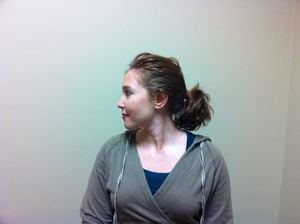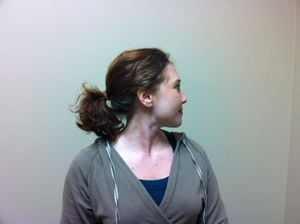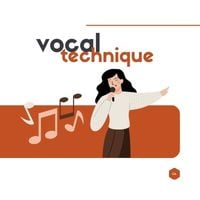Contributed by Susan Hanks, Hanks Realty Group Stager
Click Link for soft copies: Vocal Health for Singers
What is Good Vocal Hygiene?
Vocal hygiene is caring for your voice and larynx. Improvements in vocal hygiene can impact
the way you are able to use your voice. The enclosed information will help you improve your
vocal hygiene, and therefore your vocal health.
Throat Clearing
In some cases, excessive mucus is a problem (associated with gastric reflux, post nasal drip, and allergies). More often,
patients clear their throats out of habit rather than need. This vocally traumatic behavior should be eliminated. The
following are alternative strategies to throat clearing:
1. Dry swallow-Swallowing closes the vocal folds and can rid them of mucus. The action of swallowing can also
relax the larynx helping to alleviate the sensation of needing to clear the throat.
2. Take small sips of water.
3. Use the “silent cough.”
4. Pant lightly, and then swallow.
5. Hum lightly.
6. Laugh gently or “giggle,” then swallow.
7. Talk through the mucus. The natural vibration of the vocal folds may ride them of any secretions.
8. For singers, lightly vocalize 5-note scales in a comfortable range on /a/, or crescendo on a sustained /a/.
Whispering
Most whispering should be avoided. In many instances of whispering, the anterior 2/3rds of the vocal folds approximate
or come closely together. Forced or “loud” whispering appears most harmful. The adverse effects of whispering have not
been fully documented, but there is ample clinical experience to support the recommendation against it. Although
extremely soft whispering without vocal fold contact may be safe, few patients maintain this and resort to a forced whisper
so they can be heard. Therefore all whispering should be avoided until patients can be instructed in “safe” whispering.
Yelling, Screaming, or Loud Talking
Many performers have gregarious, outgoing personalities. They commonly yell or scream as an expression of anger,
frustration, elation, or joy. We advise them to “save it for the performance” and instead:
1. Use a whistle or bell or non-voiced sound (such as hissing) to gain attention or express anger or frustration.
2. Educate friends and/or family members about the harmful effects of yelling or screaming.
3. Engage the help of others for monitoring.
4. Use facial and other physical gestures to express emotions.
5.Know your limits. Be aware of how much loud talking can be tolerated before fatigue is experienced.
6. Cultivate the dramatic power of soft, articulated speech, which is often more effective than yelling.
Noisy Environments
Certain environments are inherently noisy (cars, airplanes, restaurants, social gatherings, night clubs). Special care
needs to be taken not to speak over the noise level for long periods of time. Alternatives include:
1. Facing the listener.
2. Gently over-articulating rather than increasing loudness.
3. Slowing the speaking rate to avoid the need for repetition.
4. Speaking at a normal pitch. A normal or slightly lower pitch often cuts through the ambient noise, naturally
decreasing the need to speak more loudly. Training in the use of this technique is needed.
Excessive Talking
Gregarious patients find this a difficult habit to break. Modification can be facilitated using the following:
1. Schedule “voice naps.” Observe 20 minutes of silence, 2-3 times/day. Wear an alarm watch as a reminder to
schedule a voice nap. Alarm watches can also be useful to help in limiting telephone conversations.
2. Limit the amount of time on a telephone.
3. Limit interrupting others in conversation. Be a good listener.
Caffeine Consumption
Excessive caffeine intake has a “drying out” effect and depletes the vocal fold tissue of needed water. Patients should:
1. Avoid caffeinated beverages (coffee, soda, tea), especially before heavy voice use.
2. Switch to decaffeinated beverages (water is a good substitute).
3. Drink a glass of water for every cup of coffee/soda.
Systemic Dryness
Good systemic hydration in necessary for all patients. Instructions include:
1. Drink water every time you eat.
2. Keep water on hand at all times.
3. If you absolutely “hate” water, try bottled spring water or tap with a “twist.”
Inadequate Rest Patterns
General body fatigue is reflected in the voice. Optimal vocal efficiency may not be achieved when the patient is tired.
1. Get more rest/sleep prior to heavy voice use.
2. Be particularly careful when traveling (jet lag).
3. Allow time for a short nap prior to important speaking commitments whenever possible.
Stress Management Strategies
Many voice patients experience tremendous stress/tension in their daily lives.
1. Talk and move more slowly. When you move slower, you tend to talk slower.
2. Use physical exercise.
3. Consider meditation or prayer as desired.
4. Consider formal training in stress management with a specially trained psychologist.
Managing Laryngopharyngeal Reflux
But I don’t have heartburn?
There are two types of acid reflux—GERD (gastroesophageal reflux disease) and LPR (laryngopharyngeal reflux). GERD
occurs when acid from the stomach backs up into the esophagus. This happens because the lower esophageal sphincter
(a ring of muscle at the bottom of the esophagus) does not close properly and allows acid to flow back into the
esophagus. This irritates the lining of the esophagus, giving the sensation of heartburn. With LPR, stomach contents
reflux into the esophagus past the upper esophageal sphincter (a ring of muscle at the upper portion of the esophagus)
into the throat (pharynx), larynx (voice box), and possibly the nasal cavity. This type of reflux does not always result in
heartburn because the acid does not stay in the esophagus long enough to elicit the sensation of burning or indigestion.
Most patients with LPR do not complain of heartburn.
Symptoms of LPR
Because LPR affects the larynx (voice box), its symptoms are typically voice, airway, or swallowing-related. Heartburn
can occur with this type of reflux, but is more uncommon than with GERD. Common symptoms include:
• hoarseness or a problem with your voice, particularly in the morning
• sensation of something being “stuck” in your throat
• chronic coughing or throat clearing
• coughing after you eat or lie down
• breathing difficulties or choking episodes
• swallowing difficulties
Symptoms of GERD
• heartburn
• indigestion
• acid regurgitation
• nausea
• sensation of food being “stuck” in the chest
• sometimes chest pain that can mimic a heart attack
Why does an ENT treat reflux?
A gastroenterologist is a specialist in treating gastrointestinal (GI) disorders who often provides treatment for GERD.
Because symptoms of LPR affect the throat and/or voice box, this kind of reflux is often treated by an otolaryngologist, or
ear, nose, and throat (ENT) physician.
Treatment for Reflux
Treatment for both LPR & GERD may include the use of medications called proton pump inhibitors (PPIs) and/or H2
blockers as well as dietary and behavioral management techniques. See your physician for details.
Upper Body Stretches for Voice Therapy
(Adapted from Lessac-Madsen Resonant Voice Therapy program stretches)
In many cases, patients with voice disorders have postural and/or tension patterns which cause
excessive muscular tension and strain in the upper body, neck, and face, which can exacerbate
voice problems. Use these stretches and relaxation techniques prior to completing your voice
therapy exercises to assist in releasing the upper body musculature. You may also perform yoga
type breathing or diaphragmatic breathing while completing these exercises.
1. Chest opener-

This stretch opens up the chest and shoulders. Excellent for those of us who are typically hunched over a
computer or holding a baby most of the day! Breathe through this as you open your chest by bringing your
hands, palms facing forward, up by your shoulders and pull your shoulders back. Hold for 20-30 seconds.
2. Shoulders shrugs-

Lift your shoulders up toward your ears as you inhale. As you exhale, drop your shoulders, imagining
dropping the tension from your shoulders. Repeat several times, releasing your neck & shoulders.
3. Shoulder rolls-

Start by rolling your shoulders back several times, focusing on releasing the tension in your neck and
shoulders. After several circles back, roll your shoulders forward. Repeat this several times until you feel
you have released the tension.
4. Ear to shoulder-


Facing forward, drop your right ear to your right shoulder. Hold for approximately 5 breaths or 20-30
seconds. As you come back to neutral position, nod your head gently as if saying “yes.” Now drop your left
ear to your left shoulder. Hold for approximately 20-30 seconds; again, nodding your head “yes” gently as
you come back to neutral.
5. Looking over shoulder-


With your chest and shoulders loose and relaxed, turn to face the wall to the right, feeling a stretch in the
back of your neck on the left. Hold for 5 breaths or 20-30 seconds. Switch sides and hold for 20-30
seconds, looking to the left.
6. Jaw massage-

Start with the heels of your hands just in front of your ears. Firmly pull down toward your chin, massaging
the muscles in your jaw. Allow your tongue to relax on your lip as you pull the tension out of your jaw.
7. Jaw stretch-

Make an “L” with your thumb and first finger. Place your palm against your chin, pushing down and back,
as if pushing your chin toward your larynx. Relax your tongue on your lip as you release your jaw for 20-30
seconds.
8. Yawn-sigh-

Relax your face and yawn gently, allowing your jaw to release. As you exhale, sigh gently on “ah,” gliding
from high to low. Repeat this several times, allowing your larynx to release with each sigh.
9. Tongue stretch-


Stick your tongue out, spreading it out as if to cover your chin with your tongue. Hold this stretch for 20-30
seconds. If able, stand with feet hip-width apart, interlace your fingers behind your back and gently bend
forward as you stretch your tongue out on a breathy “hah,” as in the Lion Stretch in yoga.
10. Lip flutters/Tongue trills –


Relax and breathe in gently through your nose. As you exhale, allow your lips
to flutter gently. Do several of these with just air flowing out. Next, try gently voicing on a glide from high to
low while fluttering your lips on exhalation.

